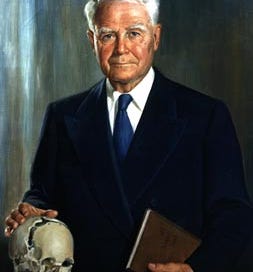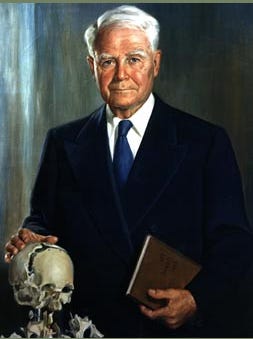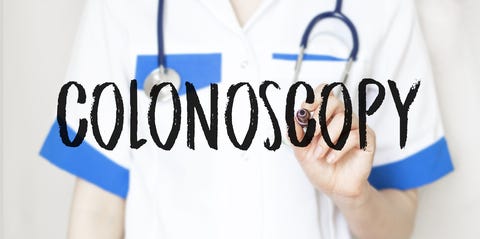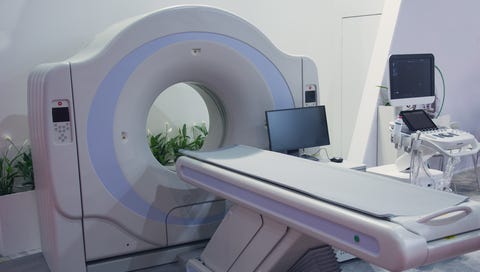
Follow: Twitter | Instagram | Telegram | Truth Social | Podcast Membership|
Broadcasts: Rumble| HappyHour |This Wk wDrT | Brighteon | Bitchute | Tues Coffee
Learn about ECP: Health Center Cleveland, OH | Health Center Ventura, CA
Websites: DrTenpenny.com |Tenpenny Apparel| Tenpenny Supplements
Click on the bulb below:
link: https://drtenpenny.com/fridayfocus
I have gotten calls from mainstream media outlets, including the Wall Street Journal, the Washington Post, and even (rarely) MSNBC and CNN for interviews or to give comments on particular vaccine topics. At some point, the researcher or reporter says something like this in a disparaging tone, “But you're ONLY an osteopath. You just specialize in bones and muscles, right?”
<sigh>
Even though the first Osteopathic medical school was opened in 1874, millions across the US still have no idea about my profession, which is both sad and aggravating.
After graduating from osteopathic medical school, DOs complete internships, residencies, and fellowships, which can last between 3 to 8 years in preparation to practice a specialty of their choosing. Here is a basic list of 26 medical specialties and subspecialties that work to represent various osteopathic perspectives. During the 2020-21 academic year, more than 25,000 DOs participated in residency and fellowship programs in 124 specialties and subspecialties. More than 2,600 of these physicians trained in programs with Osteopathic Recognition, a designation earned by ACGME-accredited postgraduate training programs for incorporating osteopathic principles and practice into the clinical learning environment. As of October 2023, there are currently 41 accredited colleges of osteopathic medicine in the United States. These colleges are accredited to deliver instruction at 66 teaching locations in 35 states. It is reported that during the current academic year, the colleges are educating more than 35,000 future physicians—25 percent of all U.S. medical students.
I probably do more every week to promote Osteopathic Medicine and the Osteopathic profession than the parent organization, the American Osteopathic Association, does each year with its $32.4M annual budget. From what I can see in their annual report, there isn’t a single dollar allocated or a line item marked as ‘marketing budget’ to educate the general public on the significance of the Osteopathic profession. (page 16) Awhile back, I sent the AOA an email asking this question: “Can you point me to the efforts and the funds used for public education so I can write about it? (I am a physician and an author).” I got no response.
The Evolution of the MD Profession
In a previous substack, I wrote about the evolution of Integrative Medicine. If you missed it, you can read it here. Let’s now take a look at the evolution of the allopathic, drug-based profession. Many books have been written on this topic; this is only a brief overview and some of the highlights. One of the best, most concise papers I’ve read on how the medical profession and its professional organization (AMA) came to be was published in 2014 in The Journal of Libertarian Studies by Ronald Hamowy, from the Department of History, University of Alberta. Entitled, “The Early Development of Medical Licensing Laws in the United States, 1875-1900,” this 44-page paper is extremely interesting. I have excerpted some of its information for this substack. If you have further interest in this topic, you can read the entire excellent paper here.
A Short History of a Big Topic
Medical schools abounded in the 1800s. Most were privately owned by the teaching faculty. Prospective student could gain admission without much difficulty and they paid the faculty directly. Among the 9 or 10 other ways to become a physician during that time included buying the certificate; completing a several-year apprenticeship; or inheriting the role from your father or grandfather.
Between 1830 and 1850, medical practitioners were loosely divided into three primary groups: Those using drug-based treatments, those who practiced homeopathy, and those who practiced what was called eclecticism.
Eclecticism was a methodology evolved by New Hampshire farmer, Samuel Thomson. He had treated his wife, his children, and a few others using herbs, steam baths, and rest. He completely dismissed the usual therapeutics of the day as ‘barbaric.’ He patented his system so that he could teach others how to heal their body with easily understood and inexpensively applied methods. Over time, eclecticism became widely accepted and used by the American public.
An even greater threat to mainstream medical orthodoxy was homeopathy. This method was put forth by German physician, Samuel Hahnemann in 1796. Homeopaths emphasized that the body had natural healing powers. This philosophy gained great popularity when introduced to Americans around 1825. Even though he had gone through the formal and rigorous medical education of his day, Hahnemann concluded that the most efficacious remedy for ailments consisted of choosing a substance which, when given to a healthy person, induced those symptoms most closely approximating the symptomatology of the disease. This became known as the law of similars, the cornerstone of homeopathic therapeutics.
Equally revolutionary was the homeopathic theory of optimal dosage. Regular physicians prided themselves on the strength and quantity of a medication administered, believing that if ten milligrams of a substance were beneficial, one hundred milligrams would likely be ten times more effective. Hahnemann argued the opposite. He determined that the smaller the dose, the more powerful the result. This became known as the law of minimums. Disparaged as “ridiculous” by drug-based practitioners, today we would call this approach “nanomedicine.”
The two alternative forms of practice became competing systems of medicine, with homeopathy especially popular in urban areas of the east coast and eclecticism settled into the Midwest and the south. Of the 62,000 physicians practicing in 1870, estimates place the number of homeopaths and eclectics at approximately 8,000, with homeopaths accounting for about two-thirds this number.
The Evolution of The American Medical Association (AMA)
The American Medical Association (AMA), founded in 1847, had little tolerance for therapies that did not use drugs and other chemical compounds to treat ailments. The profession was rapidly expanding, and homeopaths and eclectic practitioners were literally taking money out of the pockets of their allopathic competitors. Insurance companies as intermediary payors did not exist in those days, and regular physicians increasingly felt the need to organize and protect their pocketbooks. They opted to enlist the support of government as a means to regulate and increase the qualifications of community physicians.
In fact, the aims of the AMA, as set forth in its first charter were threefold:
The establishment of medical licensing laws that restricted the number of physicians in a given state; the intent was to create a more “stable economic climate” by inhibiting the amount of competition;
The destruction of most of the existing medical schools, replacing them with fewer, non-profit institutions of learning that would provide training to a “smaller and more select student body;” and
The elimination of “heterodox medical sects” as unwelcome and competitive forces within the profession. There was also a push to eliminate midwifery by moving births from homes to hospitals, where midwives were forbidden to practice.
In 1849, one of the first actions undertaken by the newly formed organization was to establish a board to analyze “quack remedies and nostrums” and to warn the public about the dangers of such practices. In other words, the AMA was formed to eliminate all other medical philosophies and systems in this country to stamp out the competition.
Their efforts to eliminate the competition took longer than anticipated. By 1880, of the 100 medical schools operating in that year, 14 taught homeopathic medicine, and 9 schools taught eclecticism. Despite continual denunciation of these “unfounded treatments,” they continued to be supported by the public. In 1910, the Carnegie Foundation, along with the Rockefeller Foundation, commissioned Abraham Flexnor to evaluate the state of medical education across the country and then to eliminate much of what was found. Many books have been written on this topic, and it’s far too expansive to go into here. But can read the original document for yourself to enhance this discussion.
Recall in my previous substack, we had a discussion regarding the Eisenberg Study. Despite their best efforts, regular physicians, the AMA, and today, the drug companies and their MSM mouthpieces have not been able to eliminate the public’s quest for gentle, safe, and non-toxic solutions to their health concerns.
Good at both locations, Cleveland, Ohio and Ventura, California
What Is Osteopathic Medicine
In parallel to all that was going on between allopathy, homeopathy, and eclecticism, osteopathic medicine was evolving. Osteopathic principles are centered on the idea that the person’s ability to get well comes from within in combination with a thorough knowledge of allopathically-oriented anatomy, physiology, and biochemistry.
Little known by most, osteopathic medicine was founded by an allopathic medical doctor, Andrew Taylor Still, the son of a Methodist minister. Early in his career, he served as a state legislator in Missouri and attained the rank of major during the Civil War. Dr. Taylor received his medical degree from the College of Physicians and Surgeons in Kansas City, Kansas.
The 1860 census data indicated that the country possessed over 55,000 physicians, or 175 per 100,000 population, almost certainly the highest number of doctors per capita of any nation in the world. After the Civil War ended (1865), Still became disenchanted with the accepted medical practices of the early nineteenth century, which included bloodletting, blistering, and the administration of massive doses of mercury, antimony, arsenic, and other poisonous purgatives thought to act as “tonics.” These therapeutic regimens certainly killed large numbers of persons who were unfortunate enough to undergo the treatments administered by the physicians of the day. Instead of poisoning the body with toxic substances, Still believed that the primary role of the physician was to support the body’s inherent ability to heal itself.
Although his intent was to improve the current system of medicine, not to create a new one, Still’s ideas were rejected by his peers and osteopathy was tossed into the same category as homeopathy and eclecticism: more competition.
Undeterred, and determined that his theories of health and healing were in the best interest of patients, Dr. Still proceeded to form a new medical school, Kirksville College of Osteopathic Medicine in Kirksville, Missouri, in 1874. Osteopathic medicine was developed to facilitate natural healing processes by finding and correcting structural abnormalities that could interfere with the free flow of blood and lymph fluid. Simple manual techniques, such as lymphatic drainage, were performed by the practitioners and then taught to patients to help normalize the flow of fluids, eliminate toxicities, and restore health to the individual. The principles of osteopathy—assisting the immune system to function fully and helping the body to heal itself— persist within the professional training but are used far less than they should be by osteopathic physicians.
Osteopathic Profession Today
Today, Osteopathic Medicine is a fully licensed system of medicine in parallel with, but separate from, the allopathic medicine alternative. By definition, allopathic medicine is a means by which medical doctors and other healthcare professionals (such as nurses, pharmacists, and therapists) treat symptoms and diseases using drugs, radiation, or surgery. Other names for allopathic medicine include conventional, mainstream, Western, and orthodox medicine.
The osteopathic medical profession is one of the fastest-growing segments of healthcare, representing more than 11% of all physicians in the U.S. The profession is on track to continue exponential growth, with more than one in four of all current U.S. medical students choosing to pursue osteopathic medicine. In fact, over the last decade, the number of students attending osteopathic medical school has grown by 77%.
Historically, Osteopathic Medicine is the only form of medical care that has specific tenants of how its philosophy should be practiced:
The body is a unit; the person is a unit of body, mind, and spirit.
The body is capable of self-regulation, self-healing, and health maintenance.
Structure and function are reciprocally interrelated.
Rational treatment is based upon an understanding of the basic principles of body unity, self-regulation, and the interrelationship of structure and function.
All osteopathic physicians are taught the history of osteopathy, its tenants, and techniques while in medical school. Unfortunately, most DOs go on to practice as MDs, with their prescription pad being their first-line tool. Today, patients would only know their doctor was an osteopathic physician by noting their signature, which as a DO after their name instead of an MD.
Classical osteopathy, homeopathic, and eclecticism protocols should be mainstream medical care, not tossed aside as “alternative medicine.” Having a more thorough understanding of the history of integrative medicine, allopathic medical care, the AMA and osteopathic medicine, hopefully will help you make better choices in healthcare going forward.
Here’s to your best health ever!!





















Excellent history lesson of the DO/MD development. As a heretical MD of near 50 years, I have taught in DO and MD programs and even spoken at a national DO meeting. I can assure the public that there is little practical difference between the two professions EXCEPT Osteopathy is more open to innovation and certainly more focused on holistic approaches to health and healing. Allopathic medicine is 99.9% captured by the Medical Industrial Complex while, IMO, Osteopathic medicine is a mere 80% captured. Thanks for your strong voice, Dr. T!
The biggest issue I find with "licensing" is that you fall under the control of the medical mafia to a large extent.
Operating outside the agreed protocols can land you in hot water.
As a certified naturopath, I do agree with an integrative approach(by all means if your suffering take the pill), but I am not bound to follow AMA schemes that feed the drug cartels and the greedy insurance companies and corrupt legislators in DC.
I can advise the client( I despise the world patient) that they self use a protocol(after teaching them how) that the AMA or other regulators would jump allover because of the threat it represents to the entire industry.
Just for an easy example:
If a client comes to me with a particular issue that treatment with the licensed profession has not been able to cure(say squamous cell carcinoma which is a popular one it seems) and is tired of the having to go to the dermatologist to have it removed, then I can start to investigate the "why" it is happening?
After many things I would do as a "certified" naturopath and being a detective, I would tell them to fast intermittingly, eliminate the things that are causing inflammation in the body and tell them to acquire Indonesian Vetiver eo and to apply neat(directly) upon the tumor 2x daily.
I would follow up once in about a month and that is probably the last time I would nee to see them.
Try doing this a "licensed" professional and see how long you last without getting your license suspended or revoked?
The other issue is that "licensed" medical professionals tend to create lifetime dependency in their relationships.
If the allopathic " licensed" professional would learn to do one thing the first time they see a client, test for autoimmune diseases and eliminate the catalysts, then they could cure(not maintain) 95% of all diseases.
But, this is not taught in medical school(1/2 day or one day at most) and you have to scratch your head asking why as a naturopath?
We know why.